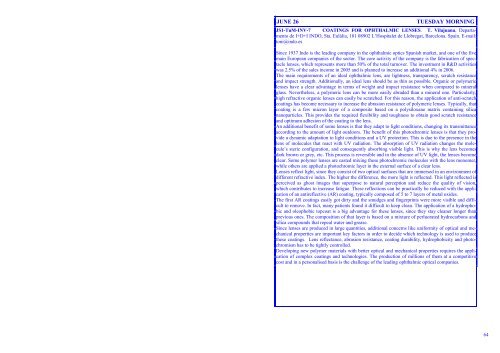Wüest M. 51 Wykes M. 82 Yamaguchi M. 17 Ybarra G. 129 Yubero F ...
Wüest M. 51 Wykes M. 82 Yamaguchi M. 17 Ybarra G. 129 Yubero F ...
Wüest M. 51 Wykes M. 82 Yamaguchi M. 17 Ybarra G. 129 Yubero F ...
You also want an ePaper? Increase the reach of your titles
YUMPU automatically turns print PDFs into web optimized ePapers that Google loves.
JUNE 26 TUESDAY MORNING<br />
JS1-TuM-INV-7 COATINGS FOR OPHTHALMIC LENSES. T. Vilajuana, Departamento<br />
de I+D+I INDO, Sta. Eulàlia, 181 08902 L’Hospitalet de Llobregat, Barcelona. Spain. E-mail:<br />
toni@indo.es<br />
Since 1937 Indo is the leading company in the ophthalmic optics Spanish market, and one of the five<br />
main European companies of the sector. The core activity of the company is the fabrication of spectacle<br />
lenses, which represents more than 50% of the total turnover. The investment in R&D activities<br />
was 2.5% of the sales income in 2005 and is planned to increase an additional 4% in 2006.<br />
The main requirements of an ideal ophthalmic lens, are lightness, transparency, scratch resistance<br />
and impact strength. Additionally, an ideal lens should be as thin as possible. Organic or polymeric<br />
lenses have a clear advantage in terms of weight and impact resistance when compared to mineral<br />
glass. Nevertheless, a polymeric lens can be more easily abraded than a mineral one. Particularly,<br />
high refractive organic lenses can easily be scratched. For this reason, the application of anti-scratch<br />
coatings has become necessary to increase the abrasion resistance of polymeric lenses. Typically, that<br />
coating is a few micron layer of a composite based on a polysiloxane matrix containing silica<br />
nanoparticles. This provides the required flexibility and toughness to obtain good scratch resistance<br />
and optimum adhesion of the coating to the lens.<br />
An additional benefit of some lenses is that they adapt to light conditions, changing its transmittance<br />
according to the amount of light outdoors. The benefit of this photochromic lenses is that they provide<br />
a dynamic adaptation to light conditions and a UV protection. This is due to the presence in the<br />
lens of molecules that react with UV radiation. The absorption of UV radiation changes the molecule’s<br />
steric configuration, and consequently absorbing visible light. This is why the lens becomes<br />
dark brown or grey, etc. This process is reversible and in the absence of UV light, the lenses become<br />
clear. Some polymer lenses are casted mixing these photochromic molecules with the lens monomer,<br />
while others are applied a photochromic layer in the external surface of a clear lens.<br />
Lenses reflect light, since they consist of two optical surfaces that are immersed in an environment of<br />
different refractive index. The higher the difference, the more light is reflected. This light reflected is<br />
perceived as ghost images that superpose to natural perception and reduce the quality of vision,<br />
which contributes to increase fatigue. These reflections can be practically be reduced with the application<br />
of an antireflective (AR) coating, typically composed of 5 to 7 layers of metal oxides.<br />
The first AR coatings easily got dirty and the smudges and fingerprints were more visible and difficult<br />
to remove. In fact, many patients found it difficult to keep clean. The application of a hydrophobic<br />
and oleophobic topcoat is a big advantage for these lenses, since they stay cleaner longer than<br />
previous ones. The composition of that layer is based on a mixture of perluorated hydrocarbons and<br />
silica compounds that repeal water and grease.<br />
Since lenses are produced in large quantities, additional concerns like uniformity of optical and mechanical<br />
properties are important key factors in order to decide which technology is used to produce<br />
these coatings. Lens reflectance, abrasion resistance, coating durability, hydrophobicity and photochromism<br />
has to be tightly controlled.<br />
Developing new polymer materials with better optical and mechanical properties requires the application<br />
of complex coatings and technologies. The production of millions of them at a competitive<br />
cost and in a personalised basis is the challenge of the leading ophthalmic optical companies.<br />
64
















